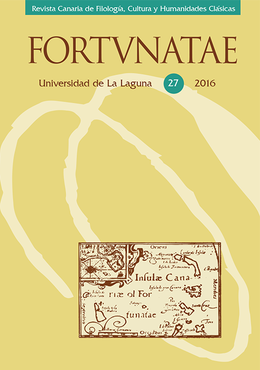Ecos catulianos en la poesía tardoantigua: el caso de Ausonio
Resumen
En el contexto literario tardo-republicano, la poesía de Catulo representó el logro de una madurez creativa que asimiló y transformó las poéticas anteriores en función de una original «política del ritmo»; asimismo la importancia del labor catuliano radica en la construcción de un libro a través del cual confirió entidad real a sus obras al contenerlas en un medio físico al que llamó libellus.
Esta idea del «artefacto textual» como instrumento de representación de la experiencia poética es la que reaparece entre los autores tardoantiguos, particularmente en el poeta galo-romano Décimo Ausonio (s. IV d. C.), en quien se advierte la preocupación por reflexionar acerca de elementos metaliterarios y programáticos, extrapolados muchos de ellos de los carmina de Catulo.
Citas
ALVAR EZQUERRA, A. (1991): «Estado actual de los estudios sobre Ausonio: Bibliografía crítica: 1960-1987», Estudios Clásicos, t. 33, nº 99: 53-98.
ALVAR EZQUERRA, A. (1990): Décimo Magno Ausonio, Obras I, Gredos, Madrid.
BATSTONE, W. (2007): «Catullus and the Programmatic Poem: The Origins, Scope and Utility of a Concept», en M. SKINNER, ed., A Companion to Catullus, Blackwell, Singapore, pp. 235-253.
CAVALLO, G. (1995): Libros, editores y público en el Mundo Antiguo. Guía histórica y crítica, Alianza, Madrid.
CLAUSEN, W. (2007 [1976]): «Catulli Veronensis Liber», en J. HAIG GAISSER (ed.), Oxford Readings of Classical Studies. Catullus, Oxford University Press, New York, pp. 56-65.
COPLEY, F. (2007 [1951]): «Catullus, c. 1», en J. HAIG GAISSER (ed.), Oxford Readings of Classical Studies. Catullus, Oxford University Press, New York, pp. 27-34.
CRISTÓBAL, V. - ARCAZ POZO, J. L. - SOLER RUIZ, A. (2000): Catulo, Poemas-Tibulo, Elegías, Editorial Gredos, Madrid.
CROWTHER, N. B. (1971): «Catullus and the traditions of the Latin poetry», CPh, vol. 66, nº 4 (Oct.): 246-249.
CULPPEPER STROUP, S. (2010): Catullus, Cicero, and a Society of Patrons. The Generation of the Text, Cambridge University Press, New York.
EVELYN WHITE, H. G. (1951): Ausonius. I-II, Heinemann, London.
FEENEY, D. (2012): «Representation and the materiality of the books in the polymetrics», en I. DU QUESNAY, T. WOODMAN (eds.), Catullus. Poems, Books, Readers, Cambridge University Press, New York, pp. 29-47.
FORDYCE, C. J. (1973): Catullus, correct reprint, Clarendon Press, Oxford.
GOOLD, G. P. (1989): Catullus, Duckworth, London.
GREEN, P. (2005): The Poems of Catullus. A Bilingual Edition, University of California Press, London.
GREEN, R. P. H. (1991): The Works of Ausonius, Clarendon Press, Oxford.
GREENE, E. (2007): «Catullus and Sappho», en M. SKINNER (ed.), A Companion to Catullus, Blackwell, Singapore, pp. 131-150.
HAIG GAISSER, J. (2009): Catullus, Blackwell, Singapore.
JOHNSON, W. R. (2007): «Neoteric Poetics», en M. SKINNER (ed.), A Companion to Catullus, Blackwell, Singapore, pp. 175-189.
KASTER, R. (1978): «Servius and Idonei Auctores», AJPh, 99: 181-209.
KNOX, P. (2007): «Catullus and Callimachus», en M. SKINNER (ed.), A Companion to Catullus, Blackwell, Singapore, pp. 151-172.
KROSTENKO, B. (2001): Cicero, Catullus, and the Language of the Social Performance, The University of Chicago Press, Chicago.
NELIS, D. (2012): «Callimachus in Verona. Catullus and Alexandrian poetry», en I. DU QUESNAY, T. WOODMAN (eds.), Catullus. Poems, Books, Readers, Cambridge University Press, New York, pp. 1-28.
PECERE, O. (1990): «I meccanismi della tradizione testuale», en G. CAVALLO, P. FEDELI, A. GIARDINA (eds.), Lo spazio letterario di Roma Antica, vol. III, Salerno Editrice, Roma, pp. 297-386.
PÉGOLO, L. (2012): «Representaciones tardoantiguas de lo femenino: La ekphrasis en De Bissula de Décimo Ausonio», Luthor, vol. 2, n° 11: 13-24.
PÉGOLO, L. (2013): «Ephemeris de Décimo Ausonio: un día en la vida de un aristócrata tardoantiguo», Actas y comunicaciones del Instituto de Historia Antigua y Medieval, volumen 9. <http://revistascientificas.filo.uba.ar/index.php/AcHAM/article/view/2078>
PÉGOLO, L. - CARDIGNI, J. - MEARDI, F. - RAMÍREZ, C. - ROMERO, U. (2010): Cultura y Pedagogía en el Tardoantiguo. Claves de lectura sobre los Comentarios de Servio a la Eneida, Facultad de Filosofía y Letras, Buenos Aires.
SEGAL, C. (2007 [1970]): «Catullan Otiosi: The Lover and the Poet», en J. HAIG GAISSER (ed.), Oxford Readings of Classical Studies. Catullus, Oxford University Press, New York, pp. 77-86.
SHEETS, G. (2007): «Elements of. Style in Catullus», en M. SKINNER (ed.), A Companion to Catullus, Blackwell, Singapore, pp. 190-211.
SKINNER, M. (2003): Catullus in Verona: A Reading of the Elegiac Libellus, Poems 65-116, The Ohio State University, Ohio.
TRAPPES-LOMAX, J. (2007): Catullus. A Textual Reappraisal, The Classical Press of Wales, Wales.
WISEMAN, T. P. (2007): «The Valerii Catulli of Verona», en M. SKINNER (ed.), A Companion to Catullus, Blackwell, Singapore, pp. 57-71.
WRAY, D. (2004): Catullus and the Poetics of the Roman Manhood, Cambridge University Press, Cambridge.
ZANKER, P. (1992): Augusto y el poder de las imágenes, Alianza, Madrid.
Los autores conservan los derechos de autor y garantizan a la revista el derecho de ser la primera publicación del trabajo al igual que licenciarlo bajo una Creative Commons Attribution License que permite a otros compartir el trabajo con un reconocimiento de la autoría del trabajo y la publicación inicial en esta revista.
Los autores pueden establecer por separado acuerdos adicionales para la distribución no exclusiva de la versión de la obra publicada en la revista (por ejemplo, situarlo en un repositorio institucional o publicarlo en un libro), con un reconocimiento de su publicación inicial en esta revista.





